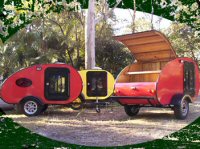doug hodder wrote:What about cold molding in ply?
In order to cold mould a shape like this trailer side, you need a former to provide the shape. These couple of photos of cold molding yachts (OK, one of them is cold mo
ulding, 'cos it's in Britain...) show the process of fitting narrow strips of thin wood (or ply) to the former - effectively it's 'make your own custom plywood':


Having made the former, you're 90% of the way to having made a mould for fiberglass - and you haven't yet started the laborious process of cold moulding. Cold moulding has dropped out of use on anything except amateur builds or very top-end yachts because it takes a long time (and plenty of skill) to do.
Really, it would be easier to make a mould and lay up a complete fiberglass side panel.
Note that cold moulding and strip planking are quite different. In cold moulding the primary joint is to the strip underneath or on top - in strip planking it is to the strips either side.
--------------------------------------------
Going back to the SMV-style side panel, here is what I think could be done. I stress it is impossible to make ply fit the SMV-shape exactly - where smooth curves are wanted, there will be some unexpected hollows and things like that. If the panels are made small enough, the unwanted features won't be too noticeable and could even be faired out with filler.

This uses a 15" offset from the outer shape and a 6" depth of bulge. Each orange line would be:
a) a joint between ply panels (so there are lots more than four), and
b) a rib under the ply panels giving them the curved shape.
The significance of this design is that each rib is the same as the others - they're all just arcs of the same (21.75") radius.
The green line shows the extent of the flat centre panel - it could have a pure curved shape, but will be easier segmented as shown.
Del, if you wanted a shape for the green curve, I can't give it - a 15" offset from an ellipse is not itself an ellipse, it's just a curved line.
Andrew

 ...
...  ...!
...!


 Doug do know what they are gluing the wood together with?
Doug do know what they are gluing the wood together with?
 Doug
Doug

